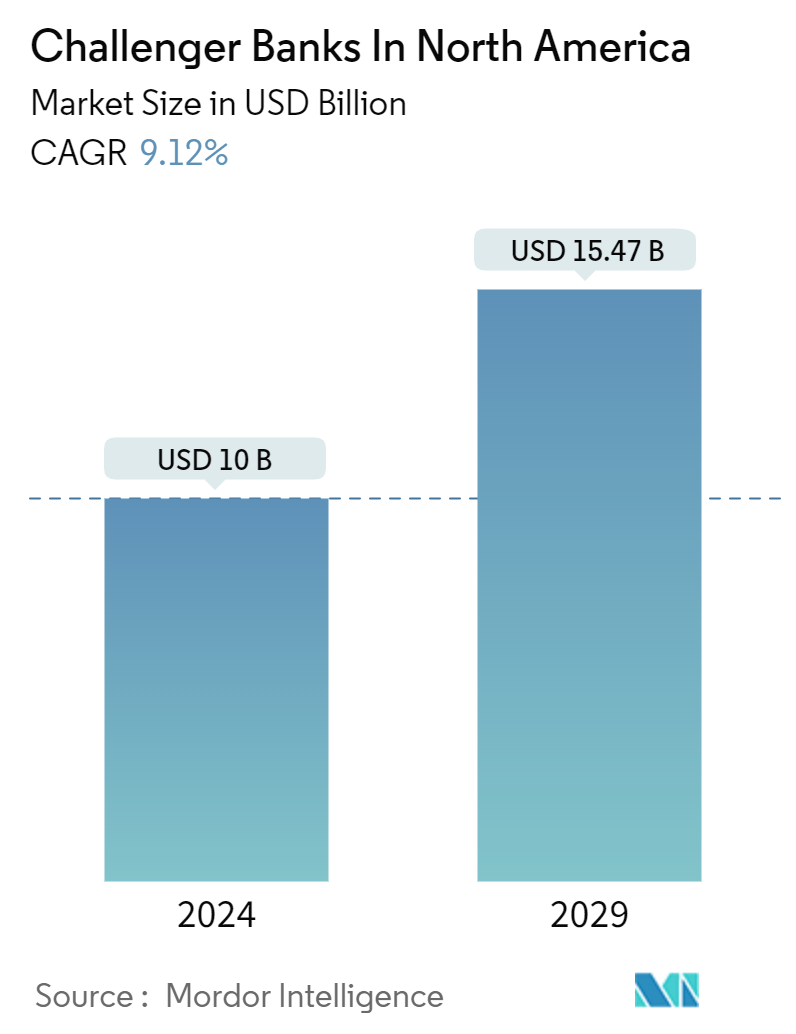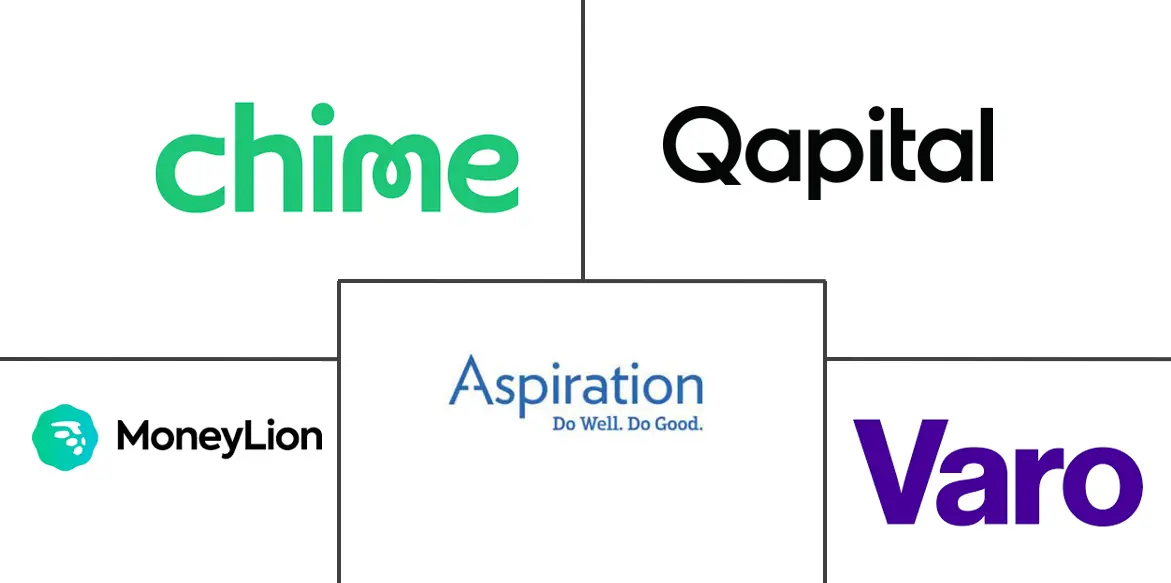Market Size of Challenger Banks In North America

| Study Period | 2020 - 2029 |
| Base Year For Estimation | 2023 |
| Market Size (2024) | USD 10 Billion |
| Market Size (2029) | USD 15.47 Billion |
| CAGR (2024 - 2029) | 9.12 % |
| Market Concentration | Medium |
Major Players
*Disclaimer: Major Players sorted in no particular order |
Challenger Banks In North America Market Analysis
The Challenger Banks In North America Market size is estimated at USD 10 billion in 2024, and is expected to reach USD 15.47 billion by 2029, growing at a CAGR of 9.12% during the forecast period (2024-2029).
Despite ongoing innovation and regulatory turmoil in financial services over the past few decades, traditional banks largely preserved their role in the financial ecosystem. Today, thousands of branch-based banks and credit unions are still in the US, and competition from new, online-focused challengers is limited. However, this may change as a groundswell of new, well-funded competition emerges from 'Challenger Banks.'
As more customers became dissatisfied with traditional banks, challenger banks rose. With no physical branches and lower overhead costs, these online and mobile-only banks can offer better products with lower fees. For younger generations, these features are appealing. Millennials are two to three times more likely to switch banks than other generations. Challenger banks are established firms that operate with a full banking license in the market.
Challenger banks are growing in popularity all over the world, with the impact of coronavirus pandemic restrictions contributing to public uptake of digital services. Challenger banks provide traditional banking products such as current accounts, savings accounts, credit and debit card schemes, and innovative new user-friendly services based on FinTech innovation and online connectivity.
Challenger Banks In North America Industry Segmentation
A challenger bank is a smaller, newer bank aiming to compete directly or challenge. these traditional banks use modern financial practices. Many turned away from branch-based banking and operated solely online or through an app. The report covers an understanding and in-depth analysis of the market size and forecasts for the various segments of the challenger banks in Europe. It includes the regulatory environment, challenger banks and their business models, detailed market segmentation, and product offerings such as deposits and loans to define their financial performance indicators, current market trends, changes in market dynamics, and growth opportunities.
The challenger banks market in North America is segmented by service type, end-user type, and country. By service type, the market is sub-segmented into loans, mobile banking, checking & savings accounts, payment & money transfers, and others. By end-user type, the market is sub-segmented into business and personal, and by country, the market is sub-segmented into the USA and Canada.
The report offers market size and forecasts for the challenger banks in North America in value (USD) for all the above segments.
| By Service Type | |
| Loans | |
| Mobile Banking | |
| Checking & Savings Account | |
| Payment & Money Transfer | |
| Others |
| By End-User Type | |
| Business | |
| Personal |
| By Country | |
| USA | |
| Canada |
Challenger Banks In North America Size Summary
The challenger banks in North America are experiencing significant growth, driven by a shift in consumer preferences towards digital-only banking services. These banks operate without physical branches, allowing them to maintain lower overhead costs and offer more competitive products with reduced fees. This model has particularly resonated with younger generations, such as millennials, who are more inclined to switch from traditional banks. The rise of challenger banks is further fueled by the increasing urbanization and the demand for efficient, user-friendly digital platforms that provide real-time services and personalized customer support. The COVID-19 pandemic has also accelerated the adoption of digital banking services, contributing to the popularity of challenger banks globally.
In the United States, the challenger bank market is supported by initiatives like the United States Fintech Network, which fosters collaboration and innovation among FinTech companies. Major players in this market, such as Chime, Varo, Aspiration, MoneyLion, and Qapital, dominate the landscape with their diverse product offerings and strategic investments in digital capabilities. These banks provide a range of traditional banking products alongside innovative services, leveraging FinTech advancements to enhance user experience. The market is characterized by a competitive environment, with a few key players holding significant market share, and ongoing developments in the sector continue to shape its growth trajectory.
Challenger Banks In North America Market Size - Table of Contents
-
1. MARKET DYNAMICS AND INSIGHTS
-
1.1 Market Overview
-
1.2 Market Drivers
-
1.3 Market Restraints
-
1.4 Industry Attractiveness - Porter's Five Forces Analysis
-
1.4.1 Bargaining Power of Suppliers
-
1.4.2 Bargaining Power of Buyers
-
1.4.3 Threat of New Entrants
-
1.4.4 Threat of Substitutes
-
1.4.5 Intensity of Competitive Rivalry
-
-
1.5 Impact of COVID-19 on the Market
-
1.6 Insights on Latest Trends and Technological Innovations in the Industry
-
-
2. MARKET SEGMENTATION
-
2.1 By Service Type
-
2.1.1 Loans
-
2.1.2 Mobile Banking
-
2.1.3 Checking & Savings Account
-
2.1.4 Payment & Money Transfer
-
2.1.5 Others
-
-
2.2 By End-User Type
-
2.2.1 Business
-
2.2.2 Personal
-
-
2.3 By Country
-
2.3.1 USA
-
2.3.2 Canada
-
-
Challenger Banks In North America Market Size FAQs
How big is the North America Challenger Banks Market?
The North America Challenger Banks Market size is expected to reach USD 10 billion in 2024 and grow at a CAGR of 9.12% to reach USD 15.47 billion by 2029.
What is the current North America Challenger Banks Market size?
In 2024, the North America Challenger Banks Market size is expected to reach USD 10 billion.

